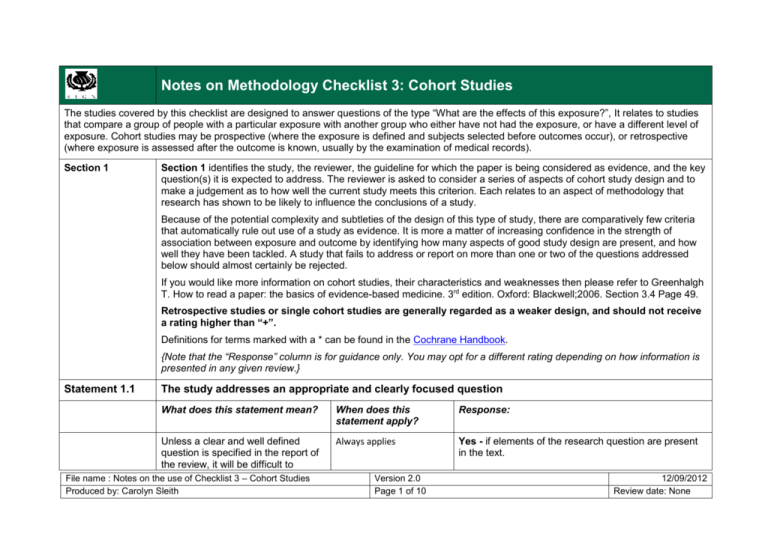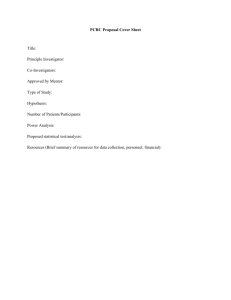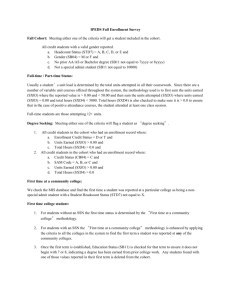Notes - SIGN
advertisement

Notes on Methodology Checklist 3: Cohort Studies
The studies covered by this checklist are designed to answer questions of the type “What are the effects of this exposure?”, It relates to studies
that compare a group of people with a particular exposure with another group who either have not had the exposure, or have a different level of
exposure. Cohort studies may be prospective (where the exposure is defined and subjects selected before outcomes occur), or retrospective
(where exposure is assessed after the outcome is known, usually by the examination of medical records).
Section 1
Section 1 identifies the study, the reviewer, the guideline for which the paper is being considered as evidence, and the key
question(s) it is expected to address. The reviewer is asked to consider a series of aspects of cohort study design and to
make a judgement as to how well the current study meets this criterion. Each relates to an aspect of methodology that
research has shown to be likely to influence the conclusions of a study.
Because of the potential complexity and subtleties of the design of this type of study, there are comparatively few criteria
that automatically rule out use of a study as evidence. It is more a matter of increasing confidence in the strength of
association between exposure and outcome by identifying how many aspects of good study design are present, and how
well they have been tackled. A study that fails to address or report on more than one or two of the questions addressed
below should almost certainly be rejected.
If you would like more information on cohort studies, their characteristics and weaknesses then please refer to Greenhalgh
T. How to read a paper: the basics of evidence-based medicine. 3rd edition. Oxford: Blackwell;2006. Section 3.4 Page 49.
Retrospective studies or single cohort studies are generally regarded as a weaker design, and should not receive
a rating higher than “+”.
Definitions for terms marked with a * can be found in the Cochrane Handbook.
{Note that the “Response” column is for guidance only. You may opt for a different rating depending on how information is
presented in any given review.}
Statement 1.1
The study addresses an appropriate and clearly focused question
What does this statement mean?
When does this
statement apply?
Response:
Unless a clear and well defined
question is specified in the report of
the review, it will be difficult to
Always applies
Yes - if elements of the research question are present
in the text.
File name : Notes on the use of Checklist 3 – Cohort Studies
Produced by: Carolyn Sleith
Version 2.0
Page 1 of 10
12/09/2012
Review date: None
No if there is no clear questioning the text.
assess how well it has met its
objectives or how relevant it is to the
question you are trying to answer on
the basis of the conclusions.
Statement 1.2
Can’t say - if you think there is insufficient detail to
allow an assessment to be made.
The two groups being studied are selected from source populations that are comparable in all respects
other than the factor under investigation.
What does this statement mean?
When does this
statement apply?
Response:
This relates to selection bias.* It is
important that the two groups
selected for comparison are as
similar as possible in all
characteristics except for their
exposure status, or the presence of
specific prognostic factors or
prognostic markers relevant to the
study in question.
Only when there is a
comparison group
YES Where characteristics of the populations from
which participants were selected are summarised
(preferably in a table).
NO Where there is no indication of how groups were
selected, or what the relevant population characteristics
were.
CAN’T SAY Where source populations are identified,
but no specific characteristics are tabulated.
NOT APPLICABLE Where there is no comparison
group.
Statement 1.3
The study indicates how many of the people asked to take part did so, in each of the groups being
studied.
What does this statement mean?
When does this
statement apply?
Response:
This relates to selection bias.* The
participation rate is defined as the
number of study participants divided
by the number of eligible subjects,
and should be calculated separately
for each branch of the study. A large
Only in prospective,
multiple cohort studies
YES Where the participation rate per group is clearly
defined.
File name : Notes on the use of Checklist 3 – Cohort Studies
Produced by: Carolyn Sleith
NO Where authors do not indicate the actual
participation rate.
NOT APPLICABLE Where there is no comparison
Version 2.0
Page 2 of 10
12/09/2012
Review date: None
difference in participation rate
between the two arms of the study
indicates that a significant degree of
selection bias* may be present, and
the study results should be treated
with considerable caution.
Statement 1.4
Statement 1.5
group.
The likelihood that some eligible subjects might have the outcome at the time of enrolment is assessed
and taken into account in the analysis?
What does this statement mean?
When does this
statement apply?
Response:
If some of the eligible subjects,
particularly those in the unexposed
group, already have the outcome at
the start of the trial the final result
will be subject to performance
bias.* A well conducted study will
attempt to estimate the likelihood of
this occurring, and take it into
account in the analysis through the
use of sensitivity studies or other
methods.
Almost always applies
YES Where sensitivity analyses are carried out to
assess the impact of this occurring.
NO Where no mention is made of this possibility.
CAN’T SAY where the possibility is acknowledged, but
no estimate of actual impact is made.
NOT APPLICABLE where the study relates to the long
term effects of an existing condition.
What percentage of individuals or clusters recruited into each arm of the study dropped out before the
study was completed?
What does this statement mean?
when does this
statement apply?
Response:
This question relates to the risk of
attrition bias.*The number of
patients that drop out of a study
should give concern if the number is
very high. Conventionally, a 20%
In prospective studies
Percentage
File name : Notes on the use of Checklist 3 – Cohort Studies
Produced by: Carolyn Sleith
Version 2.0
Page 3 of 10
12/09/2012
Review date: None
drop out rate is regarded as
acceptable, but in observational
studies conducted over a lengthy
period of time a higher drop out rate
is to be expected. A decision on
whether to downgrade or reject a
study because of a high drop out
rate is a matter of judgement based
on the reasons why people dropped
out, and whether drop out rates were
comparable in the exposed and
unexposed groups. Reporting of
efforts to follow up participants that
dropped out may be regarded as an
indicator of a well conducted study.
Statement 1.6
Comparison is made between full participants and those lost to follow-up, by exposure status.
What does this statement mean?
When does this
statement apply?
Response:
For valid study results, it is essential
that the study participants are truly
representative of the source
population. It is always possible that
participants who dropped out of the
study will differ in some significant
way from those who remained part
of the study throughout. A well
conducted study will attempt to
identify any such differences
between full and partial participants
in both the exposed and unexposed
groups. This relates to the risk of
attrition bias.* Any unexplained
Prospective, multiple
cohors studies
YES Where there has been some follow-up of drop
outs, with explanation provided.
File name : Notes on the use of Checklist 3 – Cohort Studies
Produced by: Carolyn Sleith
NO Where there is no indication that this factor has
been considered.
CAN’T SAY Where dropout rates are mentioned, but no
follow-up information is provided.
NOT APPLICABLE retrospective or single group
studies.
Version 2.0
Page 4 of 10
12/09/2012
Review date: None
differences should lead to the study
results being treated with caution.
Statement 1.7
Statement 1.8
The outcomes are clearly defined
What does this statement mean?
when does this
statement apply?
Response:
This relates to the risk of detection
bias.* Once enrolled in the study,
participants should be followed until
specified end points or outcomes are
reached. In a study of the effect of
exercise on the death rates from
heart disease in middle aged men,
for example, participants might be
followed up until death, or until
reaching a predefined age. If
outcomes and the criteria used for
measuring them are not clearly
defined, the study should be
rejected.
Always applies
YES Where endpoints or outcomes are clearly specified
and used in the analysis.
NO outcomes and measurement criteria are not
discussed.
CAN’T SAY Where definitions of outcomes and / or
methods of measuring them are unclear.
The assessment of outcome is made blind to exposure status
What does this statement mean?
When does this
statement apply?
Response:
This relates to the risk of detection
bias.* If the assessor is blinded to
which participants received the
exposure, and which did not, the
prospects of unbiased results are
significantly increased. Studies in
which this is done should be rated
more highly than those where it is
In studies with more than
one group
YES Where assessors are blinded to exposure status.
File name : Notes on the use of Checklist 3 – Cohort Studies
Produced by: Carolyn Sleith
NO Where assessors could have been blinded, but
were not.
CAN’T SAY -If randomisation is mentioned, but method
not specified.
NOT APPLICABLE Where there is only one group
Version 2.0
Page 5 of 10
12/09/2012
Review date: None
not done, or not done adequately.
Statement 1.9
being studied.
Where blinding was not possible, there is some recognition that knowledge of exposure status could
have influenced the assessment of outcome.
What does this statement mean?
When does this
statement apply?
This relates to the risk of detection
Always applies
bias.* Blinding is not possible in
many cohort studies. In order to
asses the extent of any bias that
may be present, it may be helpful to
compare process measures used on
the participant groups - e.g.
frequency of observations, who
carried out the observations, the
degree of detail and completeness of
observations. If these process
measures are comparable between
the groups, the results may be
regarded with more confidence.
Statement 1.10
Response:
YES Where process measures are detailed across
groups, and are the same or similar for each.
NO Where there is no indication if or how measures
were managed.
CAN’T SAY Where there is insufficient information to
decide how comparable measures were across groups.
The measure of assessment of exposure is reliable.
What does this statement mean?
When does this
statement apply?
This relates to the risk of detection
Always applies
bias.* A well conducted study should
indicate how the degree of exposure
or presence of prognostic factors or
markers was assessed. Whatever
measures are used must be
sufficient to establish clearly that
participants have or have not
File name : Notes on the use of Checklist 3 – Cohort Studies
Produced by: Carolyn Sleith
Version 2.0
Page 6 of 10
Response:
YES Where measures used are clearly defined and
have a known degree of accuracy.
NO Where measures are not defined.
CAN’T SAY Where it is unclear which measures were
used, or how they were defined.
12/09/2012
Review date: None
received the exposure under
investigation and the extent of such
exposure, or that they do or do not
possess a particular prognostic
marker or factor. Clearly described,
reliable measures should increase
the confidence in the quality of the
study.
Statement 1.11
Evidence from other sources is used to demonstrate that the method of outcome assessment is valid
and reliable.
What does this statement mean?
When does this
statement apply?
Response:
This relates to the risk of detection
bias.* The primary outcome
measures used should be clearly
stated in the study. If the outcome
measures are not stated, or the
study bases its main conclusions
on secondary outcomes, the
study should be rejected. Where
outcome measures require any
degree of subjectivity, some
evidence should be provided that the
measures used are reliable and
have been validated prior to their
use in the study.
Whenever any kind of
subjective measure is
used.
YES Where clearly identified primary outcome
measures are used in the analysis. If measures are
subjective, justification for their use should be provided
(eg validation of an assessment tool).
File name : Notes on the use of Checklist 3 – Cohort Studies
Produced by: Carolyn Sleith
NO Where outcome measures are not defined, or the
analysis is based on secondary outcomes.
CAN’T SAY Where subjective measures are
described, but no indication given of how they were
validated.
NOT APPLICABLE. Where measures used are
completely objective.
Version 2.0
Page 7 of 10
12/09/2012
Review date: None
Statement 1.12
Exposure level or prognostic factor is assessed more than once
What does this statement mean?
When does this
statement apply?
Response:
This relates to the risk of detection
bias.* Confidence in data quality
should be increased if exposure
level is measured more than once in
the course of the study. Independent
assessment by more than one
investigator is preferable.
Prospective studies only.
YES Where it is clearly stated that exposure level is
measured more than once.
NO Where it is clear that exposure was only checked
once.
CAN’T SAY Where there is no indication of when
exposure was measured.
NOT APPLICABLE in retrospective studies.
Statement 1.13
The main potential confounders are identified and taken into account adequately in the design and
analysis
What does this statement mean?
When does this
statement apply?
Response:
Confounding is the distortion of a link
between exposure and outcome by
another factor that is associated with
both exposure and outcome. The
possible presence of confounding
factors is one of the principal
reasons why observational studies
are not more highly rated as a
source of evidence. The report of the
study should indicate which potential
confounders have been considered,
and how they have been assessed
or allowed for in the analysis. Clinical
judgement should be applied to
consider whether all likely
Always applies
YES Where the main potential confounders are
discussed and sensitivity analyses carried out to see if
and to what extent they may have affected results.
File name : Notes on the use of Checklist 3 – Cohort Studies
Produced by: Carolyn Sleith
NO Where there is no mention of confounding.
CAN’T SAY Where confounding is mentioned, but no
comment on or analysis of potential impact on results.
Version 2.0
Page 8 of 10
12/09/2012
Review date: None
confounders have been considered.
If the measures used to address
confounding are considered
inadequate, the study should be
downgraded or rejected, depending
on how serious the risk of
confounding is considered to be. A
study that does not address the
possibility of confounding should
be rejected.
Statement 1.14
Confidence intervals are provided
What does this statement mean?
When does this
statement apply?
Confidence limits are the preferred
Always applies
method for indicating the precision of
statistical results, and can be used to
differentiate between an inconclusive
study and a study that shows no
effect. Studies that report a single
value with no assessment of
precision should be treated with
extreme caution.
Section 2
Response:
YES
NO
SECTION 2 relates to the overall assessment of the paper. It starts by rating the methodological quality of the study, based
on your responses in Section 1 and using the following coding system. The code allocated here, coupled with the study
type, will decide the level of evidence that this study provides.
The aim of the other questions in this section is to summarise your view of the quality of this study and its applicability to
the patient group targeted by the guideline you are working on.
File name : Notes on the use of Checklist 3 – Cohort Studies
Produced by: Carolyn Sleith
Version 2.0
Page 9 of 10
12/09/2012
Review date: None
How well was the study done to minimise the risk of bias or confounding, and to establish a causal relationship
between exposure and effect?
Statement 2.1
Statement 2.2
++
High quality (++): Majority of criteria met. Little or no risk of bias. Results unlikely to be changed by further research.
+
Acceptable (+): Most criteria met. Some flaws in the study with an associated risk of bias, Conclusions may change
in the light of further studies.
0
Low quality (0): Either most criteria not met, or significant flaws relating to key aspects of study design. Conclusions
likely to change in the light of further studies.
Taking into account clinical considerations, your evaluation of the methodology used, and the statistical power of
the study, do you think there is clear evidence of an association between exposure and outcome?
What does this statement mean?
This is your clinical judgement of the study
Statement 2.3
Statement 2.4
Are the results of this study directly applicable to the patient group targeted in this guideline?
What does this statement mean?
When does this
statement apply?
Response:
Does this study make sense in the
Scottish context?
Always applies
YES
NO
Notes. Summarise the author’s conclusions. Add any comments on your own assessment of the study, and the extent to
which it answers your question and mention any areas of uncertainty raised above. This section is very important and will
appear on the evidence table. PLEASE FILL IN.
File name : Notes on the use of Checklist 3 – Cohort Studies
Produced by: Carolyn Sleith
Version 2.0
Page 10 of 10
12/09/2012
Review date: None






